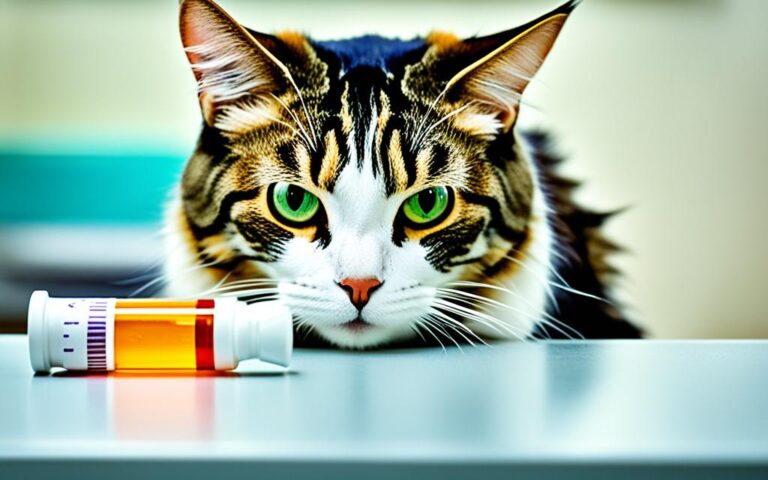Enrofloxacin (Baytril®) Guide for Cat Owners
Imagine if there was one powerful antibiotic that could treat many cat infections. From small skin issues to big lung problems. Enrofloxacin, known as Baytril®, is that medicine. It’s a strong antibiotic widely used by veterinarians all over the world1.
Baytril came to the market in 1988, and it has been helping cats since then. Most cats have no trouble with it. This medicine fights lots of different bacteria and goes deep into the body. That’s why it’s often chosen for many cat infections1.
Key Takeaways
- Baytril (Enrofloxacin) is a powerful broad-spectrum antibiotic used to treat bacterial infections in cats.
- It was developed in 1983 and became commercially available in 1988.
- Baytril is effective against a wide range of bacteria and can penetrate various bodily tissues.
- Common infections treated with Baytril include skin infections, ear infections, and urinary tract infections.
- Baytril is generally well-tolerated in cats, with mild side effects like vomiting and diarrhea being the most common.
Table of Contents
What is Enrofloxacin (Baytril®)?
Understanding the Antibiotic Class
Enrofloxacin is part of the fluoroquinolone family of antibiotics2. It stops bacteria from growing by blocking some enzymes. This action stops the bacteria from making DNA, stopping them from growing and causing infections. It can kill many types of bacteria2.
History and Development of Baytril
Baytril is the brand for Enrofloxacin. It was created by Bayer Pharmaceuticals and launched in 19833. The FDA approved it for animal use in 1988. Since then, it has been a key medicine for treating bacterial sicknesses in pets, like cats and dogs3.
This antibiotic is for pets like dogs and cats to fight certain types of bacteria. It comes in both pill and liquid form3. The pill form can be used for both types of pets, but the liquid can only be used for dogs3.
Baytril® is also given to other animals as directed by vets, even though it’s not officially approved for them. It helps by stopping bacteria from multiplying3.
If dogs are still growing, caution is needed with Baytril® between 2 and 8 months old3. It might cause issues with their bone growth. But, it’s safe for dogs that are about to have babies or that are already moms. Yet, most veterinarians don’t recommend using Baytril® during these times to be safe3.
Besides not using Baytril® in animals allergic to it, it’s risky for pets with certain brain conditions3. For people, using Baytril® can make the skin very sensitive to sunlight. Remember, it’s not for human use3.
“Enrofloxacin, the active ingredient in Baytril, is a broad-spectrum antibiotic effective against a wide range of bacteria in cats.”4
In cats, Enrofloxacin has been linked to eye problems. It’s only used when other treatments won’t work4. Still, it works against many kinds of bacteria in cats, like those causing ear or skin infections. It also helps with breathing, urinary, and stomach illnesses4.
Baytril Formulations for Cats
Enrofloxacin, known as Baytril®, comes in different forms for cats. There are chewable and coated tablets, ear drops, and injectables. This variety helps meet the varied needs of cats for better treatment outcomes.]
Oral Tablets
Baytril offers chewable and coated tablets for cats. The chewables mix easily with food, a plus for cat owners5. Coated tablets, though, must be swallowed whole to work correctly.
Otic Drops
Baytril also comes in otic drop form for ear issues. This makes treatment for ear infections precise and effective5.
Injectable Solution
Some cats can’t take medicine by mouth, like those in hospitals. For them, Baytril offers an injectable kind. Vets can give this by a shot in the muscle or vein. This ensures even these cats get the medicine they need5.

The wide selection of Baytril forms helps vets and owners choose the best choice. They consider the specific needs of each cat. This ensures cats get the medicine in the way that works best for them.
How Does Baytril Work?
Baytril is a powerful antibiotic that stops bacteria from making DNA. This makes the bacteria die. Because of this, it can kill bacteria and stop the infection from spreading6.
Its active ingredient, enrofloxacin, was developed in 1980 by scientists at Bayer AG. It was made available in 19886. This antibiotic can fight off many types of bacteria. That’s why it’s good for dealing with infections in areas like the skin, ears, and more in cats6.
Baytril is great because it gets to many parts of the body quickly. This helps it fight infections effectively. It offers a fast response to bacterial issues in cats6.
Cats should not get more than 5 mg of Baytril per kilogram of weight a day. Too much could harm their eyes. Always follow your vet’s advice and watch for any problems your cat may have taking it6.
“Baytril is a powerful broad-spectrum antibiotic that effectively targets a wide range of bacteria by disrupting their DNA replication and cell division processes.”
Baytril is an important antibiotic for cats because of how it works and its wide effect range. Always use it as directed by your vet to keep your cat safe and healthy672.
Enrofloxacin (Baytril®) for Cats
Approved Uses in Feline Patients
Enrofloxacin, or Baytril®, fights many bacterial infections in cats. It can treat skin, ear, and urinary infections. It’s also good for pneumonia and bone infections8.
Potential Off-Label Applications
Veterinarians might use Baytril® for other infections too. It can help with cat bites, anal sac, and some stomach infections. Baytril has shown it works well against many bacteria9.
But, giving cats too much, over 5mg/kg/d, can be bad. It might make them blind. Sometimes, cats get eye problems or go blind from Baytril. It can also affect the cartilage in young cats9.
So, watch for signs like changes in their eyes. And, think twice about using Baytril if a cat is pregnant or nursing. It’s not ideal for them unless it’s the best choice for the kitties9.

Beyond its main uses, Baytril helps with many cat infections. Yet, it might lead to serious eye and bone issues. That’s why vets need to be careful and check cats closely if they’re on Baytril9.
Administering Baytril to Your Cat
It’s important to carefully give your cat Baytril, an antibiotic, as the vet directs. The dosage depends on your cat’s weight and the illness they have. Usually, it’s given once a day, but your vet might suggest splitting it in two10.
Dosage Guidelines
Baytril comes in several tablet forms for cats, such as 22.7 mg, 68 mg, and 136 mg flavored tablets. There are also 68 mg unflavored tablets. Your vet will pick the right dose for your cat’s size and health issue. The medicine works quickly, in 1 to 2 hours, and its effects fade in 24 hours. This can change if the cat has kidney or liver problems10.
Directions for Use
Usually, it’s best to give Baytril tablets on an empty stomach. This helps the body absorb the medication better. But, if it upsets your cat’s stomach, you can give it with food. If your cat doesn’t like swallowing pills, chewable ones can be mixed with food. But remember, certain types of tablets must be taken whole10. For ear infections, Baytril otic drops go straight into the ear as the vet tells you11.
Following your vet’s dosing and how to give the Baytril is vital. Making sure your cat gets the right amount and follows the right schedule is key. It’s better to give this medicine when your cat hasn’t eaten. Remember, if it’s a liquid, keep it in the fridge, shake it well, and throw it out when your vet says10.
Possible Side Effects of Baytril
Baytril (enrofloxacin) is usually safe for cats, but some may experience mild side effects. These include vomiting, diarrhea, less appetite, and feeling sick and tired a lot. If you give Baytril without food, these symptoms might be more likely12. So, giving it with food can lower this risk13.
Rarely, Baytril can lead to more serious issues in cats, such as seizures or even blindness. Healthy cats don’t often have these severe reactions. But, if your cat has certain health problems, the vet will think hard about using Baytril12.
At high doses, Baytril might lead to eye damage in cats, which could make them temporarily or permanently blind. Avoid giving it with foods like cheese because they might affect how the cat absorbs the medicine12.
Always keep an eye on your cat after giving it Baytril. If you notice anything strange, tell your vet right away. The key to using Baytril safely is correct dosing and timing. This helps your cat get better without major side effects121314.
Drug Interactions and Precautions
Enrofloxacin, in Baytril®, can interact with some drugs15. It mixes badly with certain antacids. Avoid giving them together15. You should wait 2 hours between doses. Enrofloxacin can also change the effect of theophylline, a drug used for coughs, making pets more nervous and sick15.
Cats might develop dilated pupils or eye issues with enrofloxacin15. High doses could even make them blind15. Pregnant or nursing animals and young pets should avoid it due to the risk of bone deformities15.
When taken by mouth or through a vein, enrofloxacin works well16. But it can be harsh on the muscles. Pets with bad kidneys or livers or a history of seizures should be careful17.
| Potential Drug Interactions | Potential Impact |
|---|---|
| Antacids (containing calcium, aluminum, or magnesium) | Reduced absorption of enrofloxacin |
| Theophylline | Increased blood levels of theophylline, leading to side effects |
| Corticosteroids | Increased risk of tendon, joint, and cartilage damage |
| Multivitamins containing metals | Reduced absorption of enrofloxacin |
| Cyclosporine | Increased blood levels of cyclosporine, leading to toxicity |
Good pet parents talk to their vet about all their pet’s medicines. This makes using enrofloxacin safe and helpful17.
Cost Considerations for Baytril
Baytril (enrofloxacin) costs can vary. It depends on where you are, the type your vet prescribes, and if you choose the brand-name or generic18.
A week’s worth of Baytril tablets for cats runs around $30 or less19. Generic options are also available, costing between 65¢ and $3 per tablet. The brand-name Baytril is a bit more, from 85¢ to $4 per tablet19. Always talk to your vet about which is best for your cat.
For Baytril ear drops, a 15 ml bottle averages $2019. Though this seems costly, it treats ear infections well.
Remember, your cat’s health is most important. Talking with your vet helps find the best and affordable care. This way, your cat gets what they need without spending too much.
“The cost of Baytril should not be the sole factor in deciding on your cat’s treatment. Work closely with your veterinarian to find the most suitable and affordable option that addresses your cat’s specific needs.”
Storage and Handling of Baytril
It’s very important to store and handle Baytril correctly. Doing so keeps it safe and effective for your cat. Keep the oral tablets in a place that’s not too hot, away from the sun20. They last up to 5 years if kept under 25ºC in a dry spot20. Remember to keep them far from kids and pets to avoid problems.
Baytril comes in different types, like oral tablets and liquids for injection21. You can find Baytril tablets in doses of 5.7 mg, 22.7 mg, 68 mg, and 136 mg. There’s also a liquid form of 10% strength (100 mg/mL) and some injectables at 22.7 mg/mL, 5%, and 10% strength (100 mg/mL)21. Keep the liquids at room temperature and away from light21.
Storing Baytril well is key to making sure it works right and doesn’t harm anyone. Always follow the maker’s storage tips and keep it out of kids’ and pets’ reach. This will help your cat get all the good from this medicine22.
Keep in mind, Baytril is serious medicine and needs a vet’s say-so to use. Don’t give it to your cat without talking to your vet first. Your vet can give you the best advice on how to use and store it safely for your cat’s health212220.
Enrofloxacin (Baytril®) for cats
Enrofloxacin, known as Baytril®, fights many kinds of bacterial infections in cats23. It’s in the fluoroquinolone group, which covers a wide range of bacteria. This antibiotic is able to reach different parts of the body. This makes it a key treatment in the vet’s toolbox. Knowing how to use Baytril properly is important. It helps all cat lovers make sure their pets get better safely.
Vets often use Baytril to treat cat infections. It works against skin, urine, breathing, and stomach bugs9. Cats get it either by mouth, in tablets, or as a shot. Sometimes, vets will choose Baytril for infections it’s not officially used for. This can be when it’s a key part of a bigger treatment.
Always listen to your vet on how much Baytril your cat needs9. Using more than 5mg/kg/day is not safe and may cause blindness9. Also, finish all the medicine your vet tells you to give. This keeps the infection from coming back. It also helps stop bacteria from becoming too strong for the medicine to work later on.
Most cats handle Baytril well, but there are risks9. Some may feel sick, lose their balance, or have a seizure. They might also act sad, tired, or too nervous. Their liver might not work right. In very rare cases, they could have eye problems and even lose their sight. If your cat shows any of these signs, tell your vet right away.
Knowing how to use Baytril safely and watching for problems helps a lot7. Together with your vet, you can make sure that your cat gets better without facing a lot of risks. This makes Baytril a big help in keeping cats healthy.
Conclusion
This guide has looked at how Baytril helps cats fight bacterial infections. It’s a famous vet antibiotic with many uses over time24. Its new form, DABEs, fits well with what’s needed to fight many germs24. But, when given in pill form, it might make cats sick24.
With your vet’s advice, Baytril fights these infections well in cats25. The right dose is 5 mg/kg, once a day by mouth. This method lowers the risk of eye problems, unlike higher doses25. Watching how your cat reacts, and knowing about possible drug mixes, is key to safe and good treatment26.
This Baytril guide offers a lot on using this antibiotic for your cat. Whether it’s a certain infection or you just want to learn about vet drugs, this guide is here to help. It shows you how to team up with your vet for top care for your pet24.
FAQ
What is Enrofloxacin (Baytril®) and how does it work?
What are the approved uses of Baytril for cats?
Can Baytril be used off-label for other feline infections?
How is Baytril administered to cats?
What is the typical dosage of Baytril for cats?
What are the potential side effects of Baytril in cats?
Can Baytril interact with other medications my cat is taking?
How much does Baytril cost for cats?
How should Baytril be stored?
Source Links
- Baytril (Enrofloxacin) for Cats | Great Pet Care
- Baytril for Dogs/Cats: Uses, Dosage, Side Effects – Drugs.com
- Enrofloxacin (Baytril®) for Dogs and Cats
- Baytril (Enrofloxacin) for Cats: Our Vet Explains Uses, Doses, & Side Effects – Catster
- Baytril
- Baytril for Cats – Dosage, Uses and Side Effects
- Baytril (enrofloxacin)
- Enrofloxacin | VCA Animal Hospitals
- Enrofloxacin (Baytril)
- Enrofloxacin Otic/Silver Sulfadiazine | VCA Animal Hospitals
- Mar Vista Animal Medical Center
- Baytril (Enrofloxacin) For Cats: Uses, Doses, & Side Effects – CatTime
- Enrofloxacin—The Ruthless Killer of Eukaryotic Cells or the Last Hope in the Fight against Bacterial Infections?
- Uses, Dosage & Side Effects
- Enrofloxacin For Dogs and Cats » AVRIO Pharmacy
- New Animal Drugs; Approval of New Animal Drug Applications; Withdrawal of Approval of New Animal Drug Applications
- Baytril for Dogs | Wag!
- Enrofloxacin / Baytril
- Enrofloxacin in Vet Medicine – Facts and Information | PetCoach
- Baytril (enrofloxacin) Tablets – Heartland Vet Supply
- Evaluation of a Tasteless Enrofloxacin Pharmaceutical Preparation for Cats. Naive Pooled-Sample Approach to Study Its Pharmacokinetics
- No title found
- doi:10.1053/j.jepm.2005.11.011







